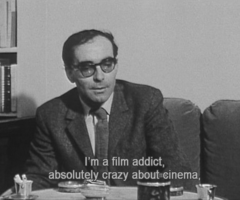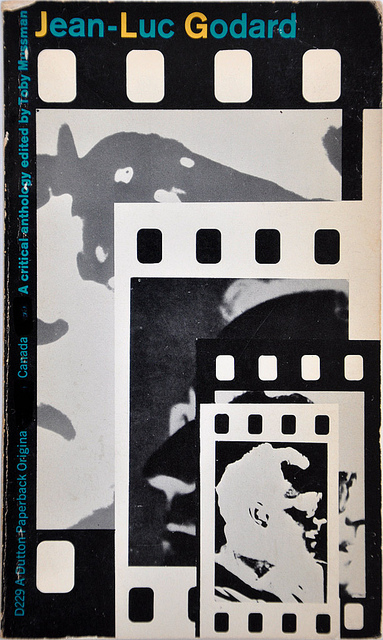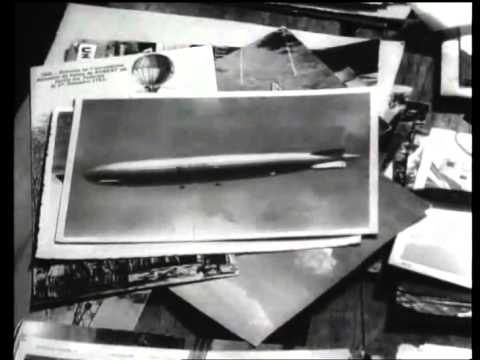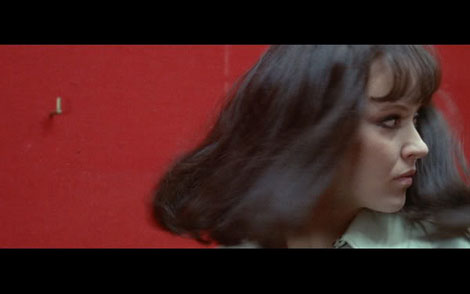From Film Society Review, Vol. 4, No. 4 (December 1968). — J.R.
****************************************************
JEAN-LUC GODARD: A critical anthology
edited by Toby Mussman. New York: E. P.
Dutton & Co.,1968., 319 pages,$2.45 (paperback).
***************************************************
For most people interested in Godard, Toby Mussman’s collection of writing on his films is bound to be useful. For this reader, it manages to be both indispensable and exasperating. For its range and its better pieces, it far outflanks the two previously published books on Godard in English — Richard Roud’s GODARD (Doubleday) and THE FILMS OF JEAN-LUC GODARD (another anthology, edited by Ian Cameron and published in England by Studio Vista). But like its predecessors, it suffers from wildly uneven displays of taste and judgment.
To take a case in point, one is grateful for the seven pieces by Godard in the book, which throw considerable light on his work and are fun to read besides; included are the scenarios of A WOMAN IS A WOMAN and VIVRE SA VIE, a fascinating monologue on PIERROT LE FOU, and a reply to critics of LES CARABINIERS. But the English translations of most of these pieces are grotesque. Unless the reader knows the French titles of American films, references to LA CROISIERE DU NAVIGATOR (Keaton’s THE NAVlGATOR) and “the ‘Aurore’ trolley” (the trolley ride in Murnau’s SUNRISE) are likely to appear meaningless; the English rendering of “Feu sur LES CARABINIERS” — “Taking Pot Shots at THE RIFLEMEN” — is a product of the translator’s cuteness, not Godard’s. And the other major drawback of the translations — awkward and frequently cloudy prose — crop up in many of the native contributions as well.
Other evidences of carelessness include a mislabeling of the last still in the volume (which, like the other stills, seems arbitrarily chosen) and the use of the original version of Susan Sontag’s important essay on VIVRE SA VIE instead of the updated one that appears in AGAINST INTERPRETATION. And in general, one can question the editor’s selection of essays even if one grants him his mainly restricted sources — why, for instance, were the articles by Luc Moullet and Jean-André Fieschi from CAHIERS DU CINEMA IN ENGLISH included, rather than the ones by Bernardo Bertolucci and Michel Delahaye?
But having raised these objections, I should reiterate that JEAN-LUC GODARD is a book well worth having. Robin Wood’s “Society and Tradition: An Approach to Jean-Luc Godard” — which the editor discovered, with a rare burst of resourcefulness, in NEW LEFT REVIEW — contains many meaningful insights, not the least of which is a simple statement (“. . . Godard rejects society because society has rejected tradition”) that “explains” a virtual arsenal of impulses and stances in Godard’s work that most of the other essays either choke on or bypass completely. Andrew Sarris’ review of A WOMAN IS A WOMAN and “Waiting for Godard” were pioneering appreciations when they first came out, and are still very much worth reading; “Light of Day,” by Raoul Coutard, includes information of particular interest to film makers; and Michael Kustow’s “Without and Within” contains an acute political analysis of MADE IN U.S.A. and 2 OU 3 CHOSES QUE JE SAIS D’ELLE. There are four interesting interviews with the director, two of which have never before appeared in English. And cogent ideas are suggested by Pauline Kael on BAND OF OUTSIDERS, John Bragin on THE MARRIED WOMAN, and David Ehrenstein on PIERROT LE FOU.
One wishes that the articles on CONTEMPT and ALPHAVILLE were better, and that BREATHLESS had been dealt with more adequately. But considering the difficulty of writing about Godard without being engulfed by the subject — the multiplicities of correspondences, references, paradoxes and developing ideas both between and within his films — one recognizes the formidable hardships faced by the critics in this collection. (“No other filmmaker has so consistently made me feel like a stupid ass,” Manny Farber concludes in a recent issue of ARTFORUM.) It is so tempting to simplify Godard’s metaphysics with pet theories and blanket cultural cross-references — procedures frequently used by and in reference to Marshall McLuhan — that one wishes some of the contributors had versed themselves a bit better in Godard’s original sense of film history, if only to bring their discussions somewhat closer to earth. But as the present reviewer discovered to his regret, while writing for FILM SOCIETY REVIEW two issues back, Godard criticism is much easier to prescribe than to write.




